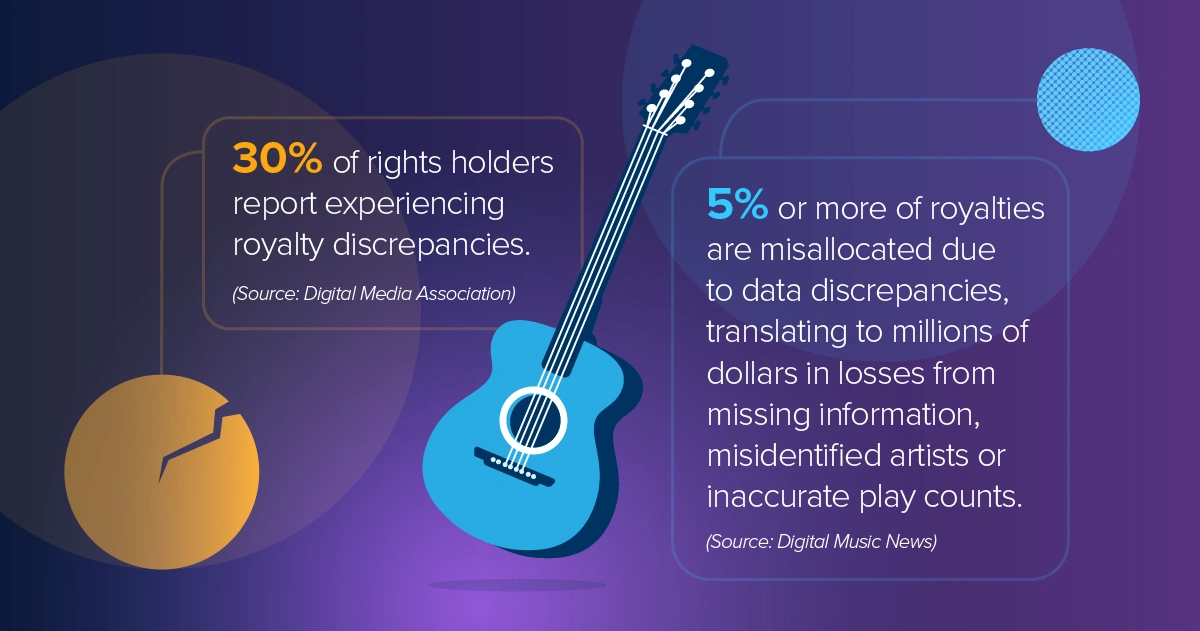
How to simplify music royalty calculations and prevent financial fallout with data-driven solutions
I believe the music industry stands at a crossroads: it may thrive on creativity, but its financial foundation rests on royalty calculations. Miscalculated royalties have serious financial repercussions for artists and rights holders. Underpayments deprive creators of their rightful income, while overpayments create financial burdens for labels and distributors.
The accurate and efficient calculation and distribution of royalties — from streaming payouts to mechanical licenses and more — is paramount. Royalties are the compensation creators receive for their intellectual property (IP). Whether it’s a chart-topping hit, a sync placement in a blockbuster film or a streaming play on repeat, royalties must flow seamlessly through the music ecosystem.
Ball ‘n chain: 6 royalty management challenges
Navigating this intricate system comes with some challenges, including:
- Data complexity
The sheer volume and diversity of data — streams, downloads, syncs, performances and more — can overwhelm even the most seasoned industry professionals. Consolidating data from various sources requires robust data pipelines and integration.
- Multiple revenue streams
Music generates income from streaming services, digital downloads, radio airplay, public performances and synchronization licenses. Complexity is increased by the distinct royalty structures specific to each revenue source.
- Contractual complications
Contracts between artists, songwriters, record labels, publishers and distributors often include deductions, advances and variable royalty splits based on territory, deductions for production and marketing costs, and recoupment clauses for advances provided by labels, adding more layers of complexity.
- Data discrepancies
Distributors and platforms often have varying data collection and reporting practices. Data inconsistencies can lead to errors in royalty calculations, potentially costing rights holders significant sums.
- Global royalty landscape
Music transcends borders — and so do royalties. Managing international rights, currency conversions and local regulations demands a global perspective. A misstep can lead to missed payments or legal entanglements.
- Transparency and trust
Artists and creators rely on accurate statements and timely payments. Royalty systems must provide real-time insights, allowing rights holders to track their earnings and make informed decisions.
To me, these challenges hinder transparency within our industry and result in significant financial losses for rights holders.
Trouble no more: Data-driven solutions
The digital age demands a data-savvy approach to music royalties. A data-driven future for royalties holds great promise for the music industry, but from my perspective, it requires a collective effort from all stakeholders to embrace change and harness the power of data. Automation reduces errors and frees up human resources for strategic tasks, while predictive models can forecast revenue streams, identify trends and optimize licensing strategies.
Legacy systems may struggle with the massive amount of data generated by streaming platforms. Data-driven solutions can further enhance transparency and efficiency through:
- Metadata harmonization to ensure crucial data — artist names, song titles, ISRC (International Standard Recording Code) codes — is not lost during music uploads. Inaccurate or missing metadata leads to misattribution and misallocation of royalties. Standardizing metadata formats and implementing robust data cleansing procedures are crucial.
- Real-time royalty monitoring to track music usage across platforms, allowing artists and labels to demand their rightful earnings promptly.
- Multi-territory solutions that simplify royalty distribution across geographic borders, reducing deductions and enhancing control for rightsholders.
- Dashboards that allow rights holders to monitor their royalties and make more informed decisions.
- Archive maintenance that enables labels and publishers to properly adhere to future audits initiated by artists and songwriters seeking to confirm proper payments.
In my opinion, the most critical part before implementing a data-driven solution is to follow best practices for data input. Proper procedures when entering data correctly into relevant fields will save considerable time and headaches later on when you may need to export or edit the data.
Let the good times roll
Navigating the royalties labyrinth doesn’t need to be a daunting task. In an era of fragmented revenue streams and global distribution, efficient music royalty management is a crucial differentiator for artists, labels and publishers.
I firmly believe that the need for data-driven solutions will continue to intensify in the world of music royalties where precision is a necessity, not a luxury. Mastering a data-driven approach ensures all players in the music industry receive fair compensation and maximize their potential revenue streams.
Get your mojo back and transform your music royalty management for a brighter future.
Get the latest news, updates, and exclusive insights from Vistex delivered straight to your inbox. Don’t miss out—opt in now and be the first to know!


